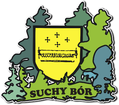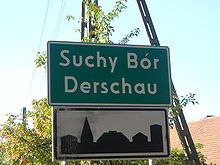Look
| Derschau Suchy Bór |
||
|---|---|---|

|
|
|
| Basic data | ||
| State : | Poland | |
| Voivodeship : | Opole | |
| Powiat : | Opole | |
| Gmina : | Chronic jam | |
| Geographic location : | 50 ° 39 ' N , 18 ° 4' E | |
| Height : | 152 m npm | |
| Residents : | 882 () | |
| Postal code : | 46-053 | |
| Telephone code : | (+48) 077 | |
| License plate : | OPO | |
| Economy and Transport | ||
| Street : | Częstochowa - Opole | |
| Rail route : | Zawadzkie – Opole | |
| Next international airport : | Katowice | |
Derschau ( Polish Suchy Bór ) is a place in the municipality Chronstau in the Powiat Opolski in the Opole Voivodeship in Upper Silesia in Poland .
geography
Derschau is eight kilometers east of the city center of Opole in historic Upper Silesia . The village is surrounded by forest to the north, west and south.
history
founding
According to a decree of the Prussian King Frederick the Great , the colonist village of Derschau was founded on March 30, 1773. The forest master Burich from Bolko cleared the forest in the Dürrheide and created a new settlement here in the course of the Frederician colonization. Derschau is thus the youngest village in the municipality.
Naming
The name Derschau was given to the colony by the War and Domain Chamber in Breslau in 1774. The locals called the settlement "Drze Heide" to distinguish it from the marshland in Lendzin and Chronstau . Indeed, most of the colony had arid sandy soils.
The village
The Derschau colony was built in a similar style to other colonies - as a so-called street village . All houses were the same. They were wooden houses with brick chimneys, with a shingle or thatched roof. In each house there was a living room, two pantries and a stable. Each house cost the Prussian state 150 thalers. Each colonist had to build a barn and a shed himself. Bread was baked in a bakery for the whole village. Residents fetched water from four wells. The settlers came from Hesse, Württemberg, Thuringia, Austria, Poland and the neighboring villages. There were 20 “jobs” (households) in the village. Each colonist received 12 acres of fields, 4 acres of meadow, one acre for the garden and one pasture.
In the referendum in Upper Silesia on March 20, 1921, which was accompanied by conditions similar to civil war in the area , 179 people voted in Derschau to stay with Germany and 77 for Poland. Like the entire constituency of Opole, Derschau remained with the German Empire.
In 1945 the place fell to Poland as Suchy Bór .
In 2006, the Chronstau community introduced German as an auxiliary language and in 2008 also German place names.
Population development
The population of Derschau:
|
|
building
The first school in Derschau was built in 1774. It was an evangelical school exclusively for children from Derschau. In 1895 a new school was built.
In 1901, a sawmill that still exists today and a train station that still exists today were built. The founders of the sawmill were Friedrich Stelling and the colonist Giesa. But the owners of the plant often changed. The last one was the businessman Berthold Winkler until the Second World War.
1906–1907 Opole built a rest home for children with respiratory diseases on the outskirts of the village of Derschau (Ośrodek Rehabilitacji Dzieci i Młodzieży).
Between 1981 and 1982 the residents of Derschau built a church at the suggestion of Pastor Ernest Kubon. It was built in place of the Jończyk family's old carpentry workshop.
There is also the Aquapark swimming pool on the main street A. Pawlety and two grocery stores, "GS Chrząstowice" on the main street A. Pawlety and "ABC Sklep" on ulica 1. maja.
Web links
Individual evidence
- ↑ cf. chrzastowice.pl ab. on Oct 18, 2009
- ↑ http://home.arcor.de/oberschlesien-bw/abwahl/oppeln.htm ( Memento from January 24, 2017 in the Internet Archive )
- ↑ Sources of the population figures : 1784: [1] - 1830: [2] - 1844: [3] - 1855, 1861: [4] - 1910: [5] - 1933, 1939: [6]





